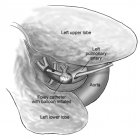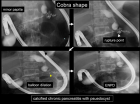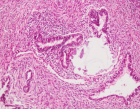Abstract
Case Report
Foley catheter balloon tamponade as a method of controlling iatrogenic pulmonary artery bleeding in redo thoracic surgery
Marcus Taylor*, Muhammad Asghar Nawaz, Ozhin Karadakhy, Denish Apparau, Kandadai Rammohan and Paul Waterworth
Published: 20 November, 2019 | Volume 3 - Issue 1 | Pages: 047-049
Background: Pulmonary artery bleeding secondary to iatrogenic injury is a troublesome intraoperative complication. The likelihood of encountering this complication is significantly higher in redo surgery for a number of reasons, including distortion of anatomical structures, adhesions and loss of tissue planes. Significant blood loss, although rare, remains a concern, and can occasionally be life-threatening. When significant bleeding from the pulmonary artery occurs, it can be a challenging situation to manage.
Case Report: A 65 year old female was undergoing redo thoracic surgery in the setting of a completion lobectomy for biopsy-proven primary adenocarcinoma of the lung. Iatrogenic injury to the pulmonary artery resulted in significant bleeding that could not be managed by gaining proximal control due to dense adhesions. The novel decision to utilize a Foley catheter for balloon tamponade was taken, in order to provide sufficient haemostasis for definitive surgical repair of the defect to be undertaken
Conclusion: The increased technical difficulties of redo thoracic surgery are well recognised. We describe the first case of Foley catheter balloon tamponade being utilized in the context of iatrogenic pulmonary artery bleeding during thoracic surgery.
Read Full Article HTML DOI: 10.29328/journal.acr.1001023 Cite this Article Read Full Article PDF
Keywords:
Pulmonary artery; Iatrogenic injury; Foley catheter
References
- Nwaejike N, Elbur E, Malagon I, Dodman N, Hewitt K, et al. Is there a role for the high-risk multidisciplinary team meeting in thoracic surgery? Interact Cardiovasc Thorac Surg. 2016; 22: 397-400. PubMed: https://www.ncbi.nlm.nih.gov/pubmed/26810916
- Lung cancer clinical outcomes publication 2016. Royal College of Physicians & Society for Cardiothoracic Surgery in Great Britain & Ireland.
- Agostini P, Cieslik H, Rathinam S, Bishay E, Kalkat MS, et al. Postoperative pulmonary complications following thoracic surgery: are there any modifiable risk factors? Thorax. 2010; 65: 815-818. PubMed: https://www.ncbi.nlm.nih.gov/pubmed/20805178
- Lim E, Baldwin D, Beckles M, Duffy J, Entwisle J, et al. Guidelines on the radical management of patients with lung cancer. British Thoracic Society. 2010. PubMed: https://www.ncbi.nlm.nih.gov/pubmed/20940263
- Omasa M, Date H, Takamochi K, Suzuki K, Miyata Y, et al. Completion lobectomy after radical segmentectomy for pulmonary malignancies. Asian Cardiovasc Thorac Ann. 2016; 24: 450–454. PubMed: https://www.ncbi.nlm.nih.gov/pubmed/27207503
- Taylor H, Williams E. Arteriovenous fistula following disk surgery. Br J Surgery. 1962; 50: 47-50. PubMed: https://www.ncbi.nlm.nih.gov/pubmed/13919962 v
- Elmoghrabi A, Mohamed M, Eggers A, Parmar N, McCann M. More than just a urinary catheter - Haemorrhage control by using a Foley catheter in a penetrating aortic root injury. Trauma Case Rep. 2016; 5: 13-17. PubMed: https://www.ncbi.nlm.nih.gov/pubmed/29942849
- Feliciano DV, Burch JM, Mattox KL, Bitondo CG, Fields G. Balloon catheter tamponade in cardiovascular wounds. Am J Surg. 1990; 160: 583-587. PubMed: https://www.ncbi.nlm.nih.gov/pubmed/2252117
- Weppner J. Improved mortality from penetrating neck and maxillofacial trauma using Foley catheter balloon tamponade in combat. J Trauma Acute Care Surg. 2013; 75: 220-224. PubMed: https://www.ncbi.nlm.nih.gov/pubmed/23823611
- Navsaria P, Thoma M, Nicol A. Foley catheter balloon tamponade for life-threatening hemorrhage in penetrating neck trauma. World J Surg. 2006; 30:1265-1268. PubMed: https://www.ncbi.nlm.nih.gov/pubmed/16830215
Figures:

Figure 1
Similar Articles
-
Foley catheter balloon tamponade as a method of controlling iatrogenic pulmonary artery bleeding in redo thoracic surgeryMarcus Taylor*,Muhammad Asghar Nawaz,Ozhin Karadakhy,Denish Apparau,Kandadai Rammohan,Paul Waterworth. Foley catheter balloon tamponade as a method of controlling iatrogenic pulmonary artery bleeding in redo thoracic surgery. . 2019 doi: 10.29328/journal.acr.1001023; 3: 047-049
Recently Viewed
-
Forensic Comparison of Textile Fibre for Identification using X-ray Diffraction TechniqueMC Janaki*,S Anil Kumar. Forensic Comparison of Textile Fibre for Identification using X-ray Diffraction Technique. J Forensic Sci Res. 2023: doi: 10.29328/journal.jfsr.1001055; 7: 083-088
-
Scientific Analysis of Eucharistic Miracles: Importance of a Standardization in EvaluationKelly Kearse*,Frank Ligaj. Scientific Analysis of Eucharistic Miracles: Importance of a Standardization in Evaluation. J Forensic Sci Res. 2024: doi: 10.29328/journal.jfsr.1001068; 8: 078-088
-
Crime Scene Examination of Murder CaseSubhash Chandra*,Pradeep KR,Jitendra P Kait,SK Gupta,Deepa Verma. Crime Scene Examination of Murder Case. J Forensic Sci Res. 2024: doi: 10.29328/journal.jfsr.1001071; 8: 108-110
-
Dental Age Estimation using the Cameriere Method in Different Countries: A ReviewDesprika Youhana Sitio*, Ghora March Eka Solehuddin, Grace Sisilia Panjaitan. Dental Age Estimation using the Cameriere Method in Different Countries: A Review. J Forensic Sci Res. 2024: doi: 10.29328/journal.jfsr.1001062; 8: 035-039
-
A Comparative Analysis of Traditional Latent Fingerprint Visualization Methods and Innovative Silica Gel G Powder ApproachBhoomi Aggarwal*. A Comparative Analysis of Traditional Latent Fingerprint Visualization Methods and Innovative Silica Gel G Powder Approach. J Forensic Sci Res. 2024: doi: 10.29328/journal.jfsr.1001063; 8: 040-046
Most Viewed
-
Evaluation of Biostimulants Based on Recovered Protein Hydrolysates from Animal By-products as Plant Growth EnhancersH Pérez-Aguilar*, M Lacruz-Asaro, F Arán-Ais. Evaluation of Biostimulants Based on Recovered Protein Hydrolysates from Animal By-products as Plant Growth Enhancers. J Plant Sci Phytopathol. 2023 doi: 10.29328/journal.jpsp.1001104; 7: 042-047
-
Sinonasal Myxoma Extending into the Orbit in a 4-Year Old: A Case PresentationJulian A Purrinos*, Ramzi Younis. Sinonasal Myxoma Extending into the Orbit in a 4-Year Old: A Case Presentation. Arch Case Rep. 2024 doi: 10.29328/journal.acr.1001099; 8: 075-077
-
Feasibility study of magnetic sensing for detecting single-neuron action potentialsDenis Tonini,Kai Wu,Renata Saha,Jian-Ping Wang*. Feasibility study of magnetic sensing for detecting single-neuron action potentials. Ann Biomed Sci Eng. 2022 doi: 10.29328/journal.abse.1001018; 6: 019-029
-
Pediatric Dysgerminoma: Unveiling a Rare Ovarian TumorFaten Limaiem*, Khalil Saffar, Ahmed Halouani. Pediatric Dysgerminoma: Unveiling a Rare Ovarian Tumor. Arch Case Rep. 2024 doi: 10.29328/journal.acr.1001087; 8: 010-013
-
Physical activity can change the physiological and psychological circumstances during COVID-19 pandemic: A narrative reviewKhashayar Maroufi*. Physical activity can change the physiological and psychological circumstances during COVID-19 pandemic: A narrative review. J Sports Med Ther. 2021 doi: 10.29328/journal.jsmt.1001051; 6: 001-007

HSPI: We're glad you're here. Please click "create a new Query" if you are a new visitor to our website and need further information from us.
If you are already a member of our network and need to keep track of any developments regarding a question you have already submitted, click "take me to my Query."






















































































































































